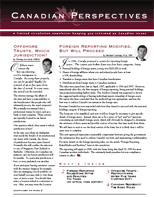
PDF Format
 Issue Contents Issue Contents
 All Issues All Issues
Canadian Perspectives - September 1998
The information in this edition of Canadian Perspectives is prepared for general interest only. Every effort has been made to ensure that the contents are accurate as of September, 1998 but professional advice should always be obtained before acting on the information herein.
Customs Duty
By Grace Chow, CA, TEP
Cadesky and Associates LLP (Toronto)
If you are moving to Canada for the first time to make this country your permanent home, you can bring in your personal and household effects as settler's effects free of duties and taxes. However, you must have owned, possessed and used these goods before you arrived in Canada. It is important that you meet all three requirements of ownership, possession, and use. For example, if you owned and possessed goods without using them, the goods are subject to duties. Personal and household effects include such items as: antiques; appliances; boats; books; family heirlooms; furnishings; jewelry; linen; musical instruments; private aircraft; private collections of coins, stamps or art; silverware; vacation trailers, and cars. Special standards apply to cars that are less than 15 years old. If your vehicle does not meet Canadian standards, you will have 45 days to bring the vehicle into compliance. Because animals may harbour pests or diseases, special rules apply to the entry of animals and household pets. Since Canada has stringent regulations on firearms, you should check first before bringing a firearm into Canada. There are also restrictions on endangered species (e.g., ivory). Before you arrive, you have to prepare two copies of a list (preferably typewritten) of all the goods you intend to bring into Canada as settler's effects, showing the value, make, model, and serial number (when applicable). Divide the list into two sections: the goods you are bringing with you, and the goods to follow. You have to present this list to the customs office when you arrive in Canada, even if you are not bringing in any goods at that time. The customs officer will prepare Form B4, Personal Effects Accounting Document, on your behalf based on the list of goods you provide. You will need to present your copy of Form B4 to claim duty and tax-free entry of your "goods to follow" when they later arrive. If you sell or give the goods away within the first year of importation, you immediately have to pay any duties that apply. The same applies to goods you begin using for commercial activities.
|